Our time in Urabá was winding down with only one full day left. Originally, the plan had been to spend this final day visiting Finca La Alborada to search for the Viridian Dacnis, a species with a very limited range in northwestern Colombia and adjacent eastern Panama. It is a very tricky bird in Panama and I had dipped on both of my trips to Cerro Pirre in Darién. Finca La Alborada is also a reliable location to search for the Rufous-crowned Antpitta. This Chocó endemic is not actually in the antpitta family (Grallariidae) but a member of the gnateater family (Conopophagidae), and it is a close relative of the Black-crowned Antpitta which I had seen last year in Panama.
 |
| Black-crowned Antpitta - Rancho Frio, Darién, Panama |
Of course, visiting Finca La Alborada was contingent on having already seen the Sooty-capped Puffbird during our first morning in Urabá, which we hadn't. And the Sooty-capped Puffbird was the instigator for visiting Urabá in the first place. Puffbirds are some of my favourite birds and this one is only found in a small section of northwestern Colombia. I could not leave Urabá without the puffbird. Alas, I wished that we still had two days to explore Urabá - one to visit Finca La Alborada, and another to seek out the puffbird - but we did not.
And so, on our final day, Carlos and I headed north to a reliable location for the puffbird called Bocas del Atrato. Laura, unfortunately, had to sit this one out as she had come down with a stomach bug the previous evening.
 |
| Black-crested Antshrike - Turbo, Antioquia, Colombia |
Reaching Bocas del Atrato is not very straightforward as one has to first travel north to the town of Turbo and then take a water taxi across the rough waters of the Gulf of Urabá to the isolated community of Bocas del Atrato. To reach Turbo, Carlos and I saved money by taking two buses and a motorbike. It is possible to stay in Bocas del Atrato. Most birders opt for this, since the water taxis do not run very early in the morning and this lowland destination heats up quickly, so planning an overnight visit is the only way to enjoy the birdy, cool hours of the morning. Carlos and I had no choice and hoped that we could find the puffbird during the heat of the day, with a plan to return via water taxi that afternoon.
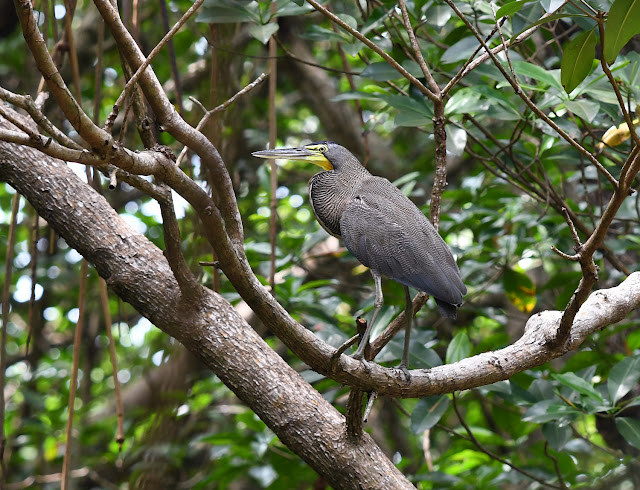 |
| Bare-throated Tiger-Heron - Bocas del Atrato, Antioquia, Colombia |
A small boardwalk near the Turbo docks accesses some mangroves. Carlos and I spent some time here while waiting to board our boat.
 |
| Turbo boardwalk, Bocas del Atrato, Antioquia, Colombia |
I foolishly hoped for Rufous-necked Wood-Rail which I still have not crossed paths with, but of course, it was not to be. There were many other birds to keep us occupied including a pair of Black-crested Antshrikes, several Buff-breasted Wrens and a flyover Northern Screamer.
 |
| Black-crested Antshrike - Bocas del Atrato, Antioquia, Colombia |
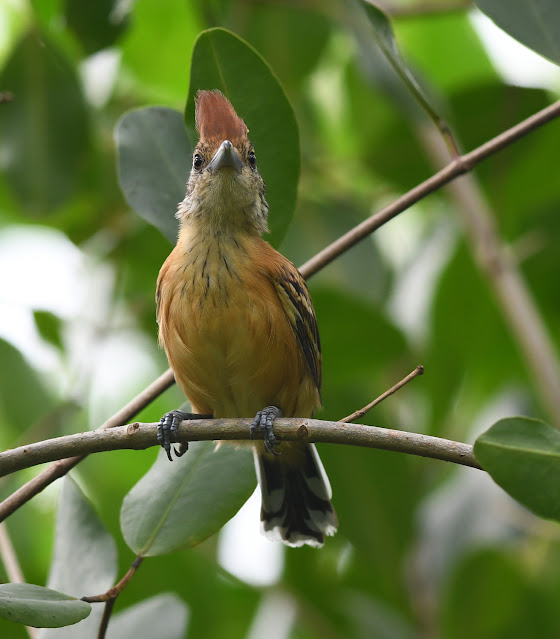 |
| Black-crested Antshrike - Bocas del Atrato, Antioquia, Colombia |
 |
| Buff-breasted Wren - Bocas del Atrato, Antioquia, Colombia |
 |
| Northern Screamer - Bocas del Atrato, Antioquia, Colombia |
I added a handful of other year-birds since this was my first time seeing the ocean in 2022 (other than a couple of days in Halifax in January) - Magnificent Frigatebird, Laughing Gull, White Ibis and several others. There were a few Rainbow Whiptail lizards scampering around to keep us occupied. The taxonomy of this genus is in flux and the powers that be are not sure what species these ones belong to.
 |
| Cnemidophorus sp. - Turbo, Antioquia, Colombia |
 |
| Cnemidophorus sp. - Turbo, Antioquia, Colombia |
This boardwalk is an easy location to find several species of crabs including this handsome Blue Land Crab.
 |
| Blue Land Crab (Cardisoma guanhumi) - Turbo, Antioquia, Colombia |
The crossing of the Gulf of Urabá was rough; as we vaulted over the waves and crashed down in the troughs my only thought was hanging on for dear life. Oh, the things us birders do for new species. Mercifully, 40 minutes later we had reached the calm waters near Bocas del Atrato.
 |
| Our water taxi - Bocas del Atrato, Antioquia, Colombia |
Bocas del Atrato is a very small town with all of the houses located in a narrow strip along the waterfront. Most of the general area consists of flooded mangroves and so there is just this small area that is not under water for at least some of the day.
 |
| The residential strip - Bocas del Atrato, Antioquia, Colombia |
We immediately walked over to a large building that had a wrap-around porch, facing off into the mangroves. It was midday and birdsong was relatively quiet. No Sooty-capped Puffbirds responded though we heard a Black Antshrike and saw both Cinnamon Woodpecker and Straight-billed Woodcreeper.
Our next stop was the only hotel located in town. The giant mural on the wall indicated that we were in the right area.
The hotel is one of the more reliable areas in town for the puffbird, especially along its small boardwalk that penetrates the mangroves. We tried walking down the boardwalk but had to abort after a dozen metres due to its dilapidated state. This was not going to plan.
And so, we resorted to plan three – hiring a friend of Carlos to take us deep into the mangroves with his boat.
For 50,000 pesos (around 16 Canadian dollars), our boatman paddled us down a tranquil stream with mangrove branches snaking up into the sky above us. We peered at promising puffbird perching places as we paddled, the only sounds being the gentle lapping of the water against the boat.
We flushed an American Pygmy-Kingfisher and noticed a Bare-throated Tiger-Heron resting quietly on a low mangrove branch. This species only barely reaches South America and Bocas del Atrato is the best location to seek it out in Colombia.
 |
| Bare-throated Tiger-Heron - Bocas del Atrato, Antioquia, Colombia |
We reached the open water of the bay as an Osprey cruised overhead. Our boatman navigated us through another narrow channel back in the mangroves. A second kingfisher appeared but this one remained in place long enough for a great view. A Green-and-rufous Kingfisher!
 |
| Green-and-rufous Kingfisher - Bocas del Atrato, Antioquia, Colombia |
 |
| Green-and-rufous Kingfisher - Bocas del Atrato, Antioquia, Colombia |
Out of the six species of kingfishers in the Americas the Green-and-rufous is perhaps the most difficult to encounter. At least, that is true in my experience (my only other sighting was a fly-by in Guyana). The Green-and-rufous Kingfisher prefers quiet streams, lagoons and mangrove areas, and it is usually much less conspicuous than the other species. The American Pygmy-Kingfisher can also be difficult to encounter as it subtly perches in similar habitats, but I have seen it on probably a dozen occasions or more. This was my first opportunity to properly study a Green-and-rufous Kingfisher.
 |
| Green-and-rufous Kingfisher - Bocas del Atrato, Antioquia, Colombia |
We eventually docked at an area of raised land, deep in the mangroves, and disembarked from our leaky watercraft. This was apparently a good area for the puffbird.
And it was. Within seconds of playing the tape, a dark shape shot into the tree above us. It took a few minutes but finally we had a clear view. My first Sooty-capped Puffbird.
 |
| Sooty-capped Puffbird - Bocas del Atrato, Antioquia, Colombia |
Its partner soon joined it, and the pair kept a wary eye on us from up in the canopy. They were a little high up for good photos and I had forgotten to pack my camera’s teleconverter. The harsh, midday sun did not help matters, but I did not really care since the views were excellent.
 |
| Sooty-capped Puffbird - Bocas del Atrato, Antioquia, Colombia |
Following that success, we bailed the water out of the boat and headed back to town, enjoying a cold beer and fried fish along the waterfront. Life is good.
We hung around for another hour or so, checking out the rest of the town and finding scant few birds. Soon, it was time for the water taxi to transport us back across the gulf which was, thankfully, a little calmer than the morning’s journey had been. A few hours later and I was safely back at the hotel to check on Laura and regale her with tales of the puffbird.
It was our last night in the area and we had a late morning flight the next day. Carlos was game for some herping. The two of us headed out on his motorbike to a farm just outside of town where he has herped on many previous occasions. He is friendly with the owners and they were happy to oblige us to enter their property for a bit of creek-walking.
It was a successful evening. The first moment of excitement was caused by a Spectacled Owl which we had disturbed during its attempted predation of a young Southern Opossum. It dropped the youngster, and Carlos quickly apprehended the unfortunate mammal. It clearly had some talon wounds on its midsection and we hoped that the owl returned soon to finish off the poor guy.
 |
| Spectacled Owl - Apartadó, Antioquia, Colombia |
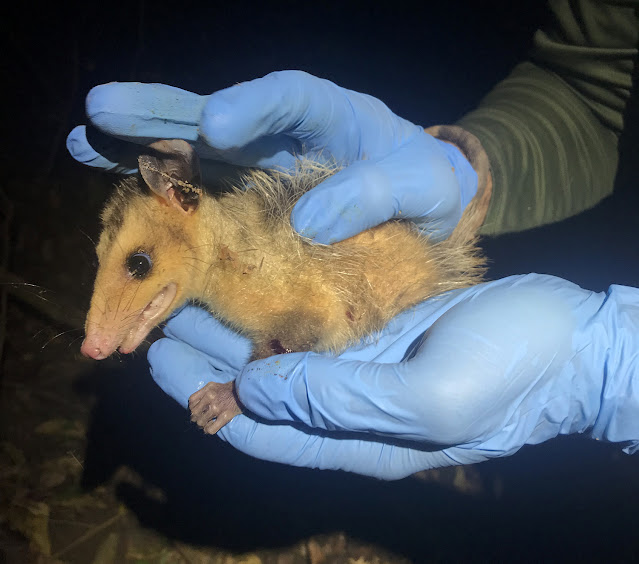 |
| Southern Opossum - Apartadó, Antioquia, Colombia |
I spotted a small cat-eyed snake along the bank of the creek, my first of 2022. Cat-eyed snakes may be common but they are attractive. The taxonomy of this genus (Leptodeira) keeps changing - I believe that the current thinking is that this is Leptodeira ornata.
 |
| Leptodeira ornata - Apartadó, Antioquia, Colombia |
The rest of the walk proved snake-less but we had many other insects, frogs, basilisks and even a small Spectacled Caiman to keep things interesting.
 |
| Craugastor raniformis - Apartadó, Antioquia, Colombia |
 |
| Common Basilisk (Basiliscus basiliscus) - Apartadó, Antioquia, Colombia |
 |
| Spectacled Caiman (Caiman crocodilus) - Apartadó, Antioquia, Colombia |
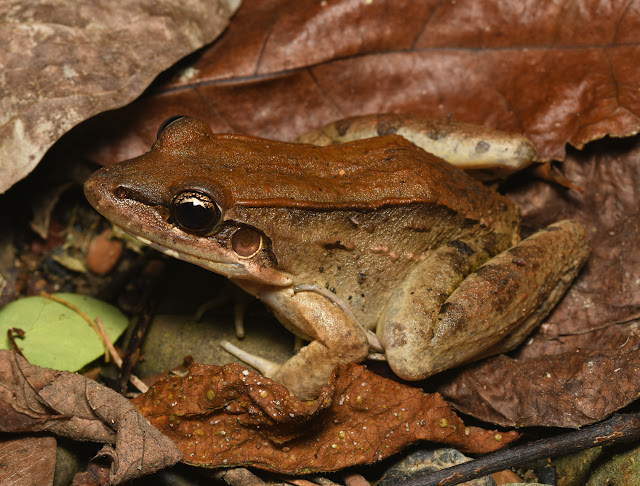 |
| Leptodactylus sp. - Apartadó, Antioquia, Colombia |
Carlos had one more surprise in store for me. There is a peculiar frog that lives in this part of Colombia, a species that is typically quite scarce but can be found in numbers during the breeding season. He had never found that species here before but a flooded, heavily-vegetated corner of a field had looked like suitable breeding habitat, and Carlos was eager to check it out.
And we were in luck. Within minutes of arrival we spotted the tell-tale bubbles at the surface of the wetland as the tiny Pipa frogs took breaths. I had never seen a Pipa frog before so this was all very exciting. We entered the wetland and were overrun with them, seeing probably close to 100 individuals during a casual investigation!
 |
| Myers' Suriname Toad (Pipa myersi) - Apartadó, Antioquia, Colombia |
This species is called Myers' Suriname Toad (Pipa myersi) and it is listed as Endangered by IUCN as it is only known from a few small locations in eastern Panama and northwestern Colombia. The frogs in the genus Pipa are some of the most unique frogs in the world, as they diverged from the other amphibians over 170 million years ago! Some of their unique features include the lack of a tongue (the prey is eaten with a “vacuum cleaner” method), the presence of tactile organs on the finger tips (used to detect food), and their inability to sit like a “normal” frog by propping themselves up with their forelimbs with their back legs folded beside their abdomen (they instead sit with their arms and legs splayed out beside their body). The tactile organs on the fingertips can be seen in the image below.
 |
| Myers' Suriname Toad (Pipa myersi) - Apartadó, Antioquia, Colombia |
Frogs in the genus Pipa have a bizarre mating system, where the eggs are deposited on the back of the female and her skin swells up around them to encase and protect the eggs. This species was truly one of the most unique amphibians I had ever laid eyes upon. Thanks, Carlos!
One of Carlos’s projects is to photograph all of the reptile and amphibian species of the region, using a softbox and a specialized studio in which he can photograph them on a white background. This setup produces excellent reference photos that can be used for comparison purposes, such as on a poster. He wanted to photograph this species and so we carefully apprehended one and placed it in a secure container. Of course, we wanted to stop by the hotel first so that Laura could see her first Pipa frog.
We had barely started the drive back when a beautiful red snake appeared in the motorcycle’s headlights! This species is referred to as Neuwied's False Boa (Pseudoboa neuwiedii). I had seen it once before but it was one of the dull grayish-brown individuals that lives in Trinidad and Tobago. This red individual was just gorgeous!
 |
| Neuwied's False Boa (Pseudoboa neuwiedii) - Apartadó, Antioquia, Colombia |
It, too was bagged up safely so that Carlos could photograph it in his studio. His plan was to release the snake and the frog the next day in the locations where they were found. While Laura unfortunately missed out on the evening’s herping, at least we returned bearing gifts.
 |
| Neuwied's False Boa (Pseudoboa neuwiedii) - Apartadó, Antioquia, Colombia |
Our time in Urabá ended but we managed to pack in so much in just four days. We thoroughly enjoyed exploring a corner of Colombia that few tourists get to see, and Carlos was the perfect companion to show us around his proverbial backyard. We would highly recommend Carlos to anyone else planning to visit this region. He does so much good work with conservation and education in Urabá and he is a great person to support. Of course, he is a top-notch guide as well, regardless if your interests are birds, herps, or anything else in the natural world. And we will be back one day to finally catch up with that Viridian Dacnis! Thank you, Carlos for an incredible visit.




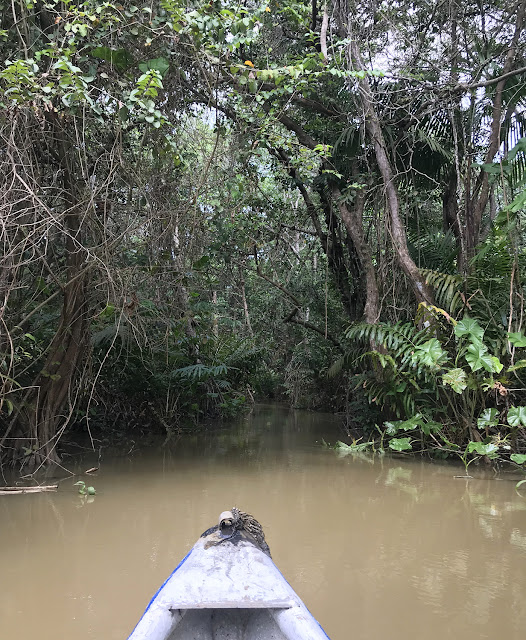



No comments:
Post a Comment